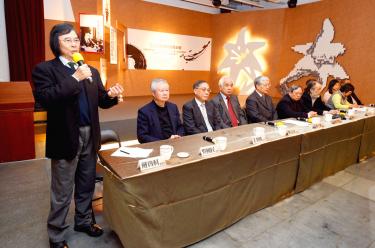The Chinese Nationalist Party (KMT) should be required to open party archives to allow academics to search for a list of people targeted during the 228 Incident, a leading expert on Taiwanese history said yesterday.
“We talk a lot about recovering the KMT’s ‘ill-gotten assets,’ but for some reason, no one seems to talk about recovering the documents stored in the party archives,” Academia Sinica’s Institute of Taiwan History research fellow Hsu Hsueh-chi (許雪姬) said at a commemorative event held at the National 228 Memorial Museum.
The KMT has been reluctant to open its historical archives in the absence of a formal legal obligation, despite ruling the nation as a one-party state for more than 50 years, Hsu said.
“The most important documents we are missing are the KMT’s; we have only seen a small proportion of the material relating to Taiwan Province,” she said. “At the very least, KMT officials would have written down any decisions that were made. Because the party led the government, those decisions would have been what government agencies implemented, so in some ways, KMT documents are a step up from official archives.”
Information on decisionmaking from the archives could shed light on how and why 228 Incident victims were targeted, she said, adding that a “name list” of targeted individuals was the key “missing link” in recent research.
The 228 Incident refers to the crackdown launched by the Chinese Nationalist Party (KMT) regime against civilian demonstrations following an incident in Taipei on Feb. 27, 1947. The event also marked the beginning of the White Terror era that saw thousands of Taiwanese arrested, imprisoned and executed.
“We do not know if the list of names [of 228 victims] was provided by a [Taiwanese] banshan [“half mountain,” a reference to those Taiwanese who went to China and joined the KMT during Japanese colonial rule], or by KMT sympathizers or others — but there must have been a list, because the regime was very methodical in making arrests,” Hsu said, adding that it was clear that intelligence agents had infiltrated opposition groups, enabling the extensive “payback,” which followed the uprising.
Other missing pieces included the division of labor between the military, police and intelligence services, as well as the exact fates of most victims, she added.
Based on the available documents, it is still impossible to determine the exact number of victims of the incident, National Central University history professor Lai Jeh-hang (賴澤涵) said.
Estimates for the number of people injured or killed range widely, from thousands to tens of thousands, with the 228 Memorial Foundation as of August last year having provided compensation in 2,288 cases, according to the foundation’s Web site.
Source: Taipei Times - 2016/02/27





















